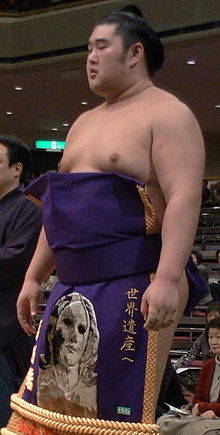- Tochinowaka Michihiro
-
栃乃若 導大
Tochinowaka MichihiroPersonal information Born Dae Won Lee
April 6, 1988
Amagasai, Hyogo, JapanHeight 1.96 m (6 ft 5 in) Weight 180 kg (400 lb; 28 st) Career Heya Kasugano Current rank see below Debut January, 2007 Highest rank Maegashira 4 (Nov, 2011) * Career information is correct as of Nov 2011. Tochinowaka Michihiro (born Dae Won Lee on April 6, 1988) is a sumo wrestler from Hyogo, Japan. His father is a Zainichi Korean and his mother is a Korean immigrant. He made his professional debut in 2007 and has steadily risen through the ranks and has begun to establish himself as a top division presence. The highest rank he has reached is maegashira 4.
Contents
Early life
Lee was active in judo and also began doing sumo in his second year of primary school. In his third year at Hotoku Gakuen High School he achieved the status of national high school yokozuna.
Career
He entered professional sumo as a wrestler for Kasugano stable in the 2007 January tournament. After posting a strong 5-2 record in his first official tournament, he achieved a perfect 7-0 record to face fellow up and coming wrestler Yamamotoyama to whom he lost the playoff bout for the jonidan championship or yusho. Promoted to sandanme in the following tournament, he posted a 6-1 record and a 5-1 record in the following tournament, garnering him promotion to makushita.
He continued fulfilling the expectations of a former high school yokozuna with four consecutive kachi-koshi or winning records. However, upon reaching upper makushita his progress slowed and he finally posted a make-koshi or losing record of 2-5, his first such record in nine tournaments in sumo. In the next tournament he only achieved a 3-4, marking the only time so far in his sumo career that he has had consecutive losing records. It was during this period of struggle that he changed to his current shikona or ring name of Tochinowaka, which is the former ring name of his stable coach, Tochinowaka Kiyotaka. His ring name up to this time had been his simple one character Korean family name of 李 or Lee. This had apparently been somewhat of a challenge for the yobidashi who are required to announce every wrestler's name in a drawn out singsong style of voice and very rarely, if ever, had to call out a ring name consisting of just one syllable.
His fortunes after his name change did not change right away, and after several tournaments alternating between winning and losing records, with an early withdrawal in the March 2009 tournament, he finally achieved two consecutive winning records in upper makushita to grant him promotion tosekitori level, the second highest jūryō division. In contrast to his struggles previously, he soared through jūryō in just three tournaments, narrowly losing the championship in playoffs in two consecutive tournaments.
His promotion to the top makuuchi in March 2011 was ill-timed as this tournament was cancelled, the first such cancellation in the history of sumo, due to the bout fixing scandal of that year. Though there was no tournament and no official banzuke, he and fellow makuuchi promotee Kaisei did receive compensation as top division wrestlers for the period of that tournament. He only managed a 7-8 record in the following May "technical examination tournament" but has since posted two consecutive winning records, making him one of the more promising recently promoted makuuchi wrestlers. In November 2011 he reached his highest rank to date, maegashira 4.
Family
Though his father is Zainichi Korean and his mother is a Korean immigrant, Tochinowaka chose to take Japanese citizenship. This also enabled Kasugano stable to accept him despite already having a foreigner, Georgian Tochinoshin.
Fighting style
Tochinowaka is a yotsu sumo wrestler who prefers techniques involving grabbing the opponent's mawashi. His favourite grip is hidari-yotsu, with his right hand outside and left hand inside his opponent's arms. Nearly half his career victories to date have been achieved with just two kimarite or techniques, yori-kiri (force out) and oshi-dashi (push out), the two most common in sumo.
Tournament record
Tochinowaka Michihiro[1]
year in sumo January
Hatsu basho, TokyoMarch
Haru basho, OsakaMay
Natsu basho, TokyoJuly
Nagoya basho, NagoyaSeptember
Aki basho, TokyoNovember
Kyūshū basho, Fukuoka2007 (Maezumo) West Jonokuchi #32
5–2
West Jonidan #94
7–0–P
West Sandanme #80
6–1
East Sandanme #23
5–2
East Makushita #58
5–2
2008 West Makushita #38
5–2
East Makushita #22
5–2
West Makushita #13
4–3
West Makushita #10
2–5
East Makushita #23
3–4
West Makushita #28
4–3
2009 East Makushita #21
6–1
West Makushita #7
1–3–3
East Makushita #24
4–3
West Makushita #18
1–6
West Makushita #40
5–2
West Makushita #29
6–1
2010 West Makushita #11
5–2
East Makushita #6
3–4
East Makushita #11
6–1
West Makushita #4
4–3
East Jūryō #13
8–7
East Jūryō #10
11–4–P
2011 West Jūryō #2
12–3–P
Tournament Cancelled
0–0–0West Maegashira #11
7–8
West Maegashira #11
8–7
West Maegashira #7
9–6
East Maegashira #4
–
Record given as win-loss-absent Top Division Champion Retired Lower Divisions
Sanshō key: F=Fighting spirit; O=Outstanding performance; T=Technique Also shown: ★=Kinboshi(s) P=Playoff(s)
Makuuchi ranks: Yokozuna — Ōzeki — Sekiwake — Komusubi — Maegashira
Divisions: Makuuchi — Jūryō — Makushita — Sandanme — Jonidan — JonokuchiSee also
References
- ^ "Sumo Reference". http://www.sumoreference.com/Rikishi.aspx?r=6767. Retrieved 15 October 2011.
External links
Categories:- 1988 births
- Living people
- Japanese sumo wrestlers
- Sumo people from Hyōgo Prefecture
Wikimedia Foundation. 2010.

